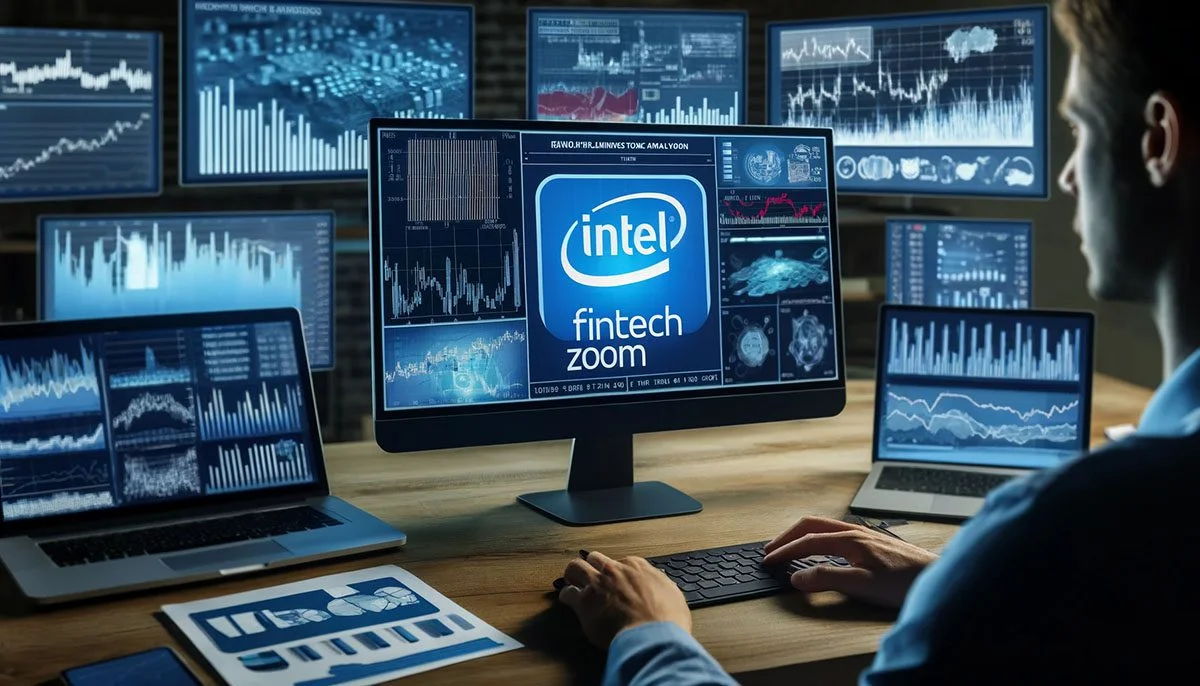Intel Corporation (NASDAQ: INTC) has long been one of the world’s most recognizable technology companies, dominating the semiconductor industry for decades. As one of the largest chipmakers globally, Intel has faced various market dynamics and challenges. This article takes an in-depth look at Intel stock through the lens of FintechZoom intel stock, exploring its performance, challenges, future prospects, and how it fits into the broader semiconductor industry.
1. Introduction to Intel Corporation
Founded in 1968, Intel is a global leader in semiconductor manufacturing and design. The company is known for producing microprocessors, the core processing unit of computers and devices. Intel’s business extends beyond processors to other semiconductor products, including memory and connectivity solutions. Over the years, the company has faced stiff competition from companies like AMD, NVIDIA, and more recently, Apple’s own M1 chip.
Intel has also made strides into other industries, including artificial intelligence (AI), 5G networks, and autonomous driving, in a bid to diversify its revenue streams.
2. Overview of Intel Stock Performance
Intel has been a significant player in the stock market for decades, maintaining a consistent position on NASDAQ. However, in recent years, The FintechZoom Intel Stock has seen its fair share of volatility due to both internal and external factors.
2.1 Historical Performance
Intel has been a blue-chip stock for much of its history, with steady dividends and growth. However, in the past decade, Intel has faced increasing challenges that have affected its stock performance. These include delays in advancing to newer process nodes (e.g., transitioning to 10nm and 7nm chips) and growing competition from rivals like AMD.
2.2 Current Stock Analysis
As of 2024, Intel’s stock has experienced both ups and downs. While it continues to generate strong revenues, the growth rate has been slower compared to peers in the semiconductor sector, such as NVIDIA and AMD. Investors are closely watching Intel’s strategies in AI and cloud computing, along with its push to regain technological leadership in semiconductor manufacturing.
3. Intel’s Competitive Landscape
Intel’s stock has been under pressure, primarily due to rising competition. To understand Intel’s stock outlook, it’s essential to review the competitive landscape.

3.1 Competition with AMD
One of Intel’s most formidable competitors is AMD, which has surged ahead in the high-performance computing segment with its Ryzen and EPYC processors. AMD has successfully closed the technological gap with Intel, offering chips with better performance and energy efficiency at lower costs.
3.2 NVIDIA’s Dominance in AI
While Intel focuses heavily on processors, NVIDIA has carved out a dominant position in the graphics processing unit (GPU) market, which has become crucial for AI and machine learning applications. NVIDIA’s acquisition of ARM Holdings and its developments in AI chips further distances itself from Intel’s traditional markets, particularly in gaming, AI, and data centers.
3.3 Apple’s Self-Sufficiency
Apple’s decision to move away from Intel chips for its Mac computers, opting for its own ARM-based M1 and M2 chips, has also put a dent in Intel’s revenue. Apple’s shift demonstrates the increasing trend of tech giants becoming more self-reliant in chip design and production, reducing their dependence on companies like Intel.
4. Recent Developments Impacting Intel Stock
In recent years, Intel has undertaken several key initiatives and faced notable challenges that have directly impacted its stock value. Let’s explore these developments.
4.1 Intel’s Push into AI and Autonomous Driving
Intel has been expanding its presence in the artificial intelligence and autonomous driving sectors through its subsidiary Mobileye. Mobileye, which Intel acquired in 2017, develops autonomous driving technologies and has partnerships with car manufacturers to provide next-generation autonomous vehicle solutions.
The demand for autonomous driving technology and advanced AI computing offers significant opportunities for growth. However, Intel faces stiff competition from companies like NVIDIA, Tesla, and Waymo.
4.2 Foundry Services and the IDM 2.0 Strategy
Intel’s IDM 2.0 strategy marks a shift from its traditional integrated device manufacturer (IDM) model, where it designs and manufactures its chips in-house. Under the IDM 2.0 plan, Intel aims to build chips for other companies as well, entering the foundry business. This move positions Intel as a direct competitor to Taiwan Semiconductor Manufacturing Company (TSMC) and Samsung.
By offering foundry services, Intel hopes to capture a share of the growing demand for semiconductors across various industries, including automotive, telecommunications, and consumer electronics.
4.3 Supply Chain Disruptions
Like many companies, Intel has faced challenges due to global supply chain disruptions caused by the COVID-19 pandemic and subsequent chip shortages. These disruptions have led to delays in product launches and have hampered production, which has impacted revenue growth.
4.4 Intel’s Environmental and Sustainability Initiatives
As part of its efforts to stay competitive, Intel has committed to sustainability and environmental goals. The company is investing in reducing its carbon footprint, aiming to achieve net-zero greenhouse gas emissions by 2040. This is an essential step for Intel as consumers and investors increasingly prioritize companies with strong environmental, social, and governance (ESG) commitments.
5. Financials and Investor Sentiment
For investors, understanding Intel’s financials is crucial for assessing the long-term viability of the stock.
5.1 Revenue and Earnings Trends
Despite the competition and production delays, Intel continues to generate billions in revenue annually. However, there has been a noticeable stagnation in revenue growth in recent years, primarily due to delayed product innovations and market share losses to competitors.
Intel has consistently paid dividends, making it a favorite for income-focused investors. The company’s dividend yield has remained relatively attractive, though dividend growth has slowed.
5.2 Balance Sheet and Cash Flow
Intel maintains a robust balance sheet with significant cash reserves, which positions it well for future investments in new technologies and acquisitions. The company’s free cash flow is also healthy, allowing it to invest in R&D while returning value to shareholders.
5.3 Stock Valuation
Compared to other semiconductor companies, Intel’s stock trades at a relatively lower price-to-earnings (P/E) ratio. This lower valuation reflects both the challenges Intel faces in regaining its competitive edge and the uncertainty surrounding its future growth prospects. For value investors, this could represent a buying opportunity, while others may be wary of potential risks.
6. Outlook and Future Prospects
While Intel has faced numerous challenges in recent years, its prospects for the future remain a mixed bag.
6.1 Advancements in Manufacturing
Intel has outlined an ambitious roadmap to regain its leadership in semiconductor manufacturing. This includes plans to catch up with TSMC and Samsung by advancing to 7nm and 5nm process nodes. If Intel can execute this strategy successfully, it will restore investor confidence and propel the stock higher.
6.2 Growth in AI and Data Centers
As AI continues to grow, Intel’s efforts to become a significant player in AI chips and data centers will be critical. The demand for cloud computing, 5G, FintechZoom intel stock and AI applications offers vast opportunities for Intel to grow beyond traditional PC and server markets.
6.3 Challenges to Overcome
Intel still faces considerable challenges. Its delays in moving to smaller chip nodes have allowed competitors to gain ground. Furthermore, the semiconductor industry is increasingly fragmented, with companies like Google, Amazon, and Tesla entering the chip-making arena for their own specialized needs. Intel will need to innovate quickly and effectively to maintain its market position.
7. Conclusion: Is Intel Stock a Buy?
Intel remains a powerhouse in the semiconductor industry, but its future success will depend on its ability to overcome competition, innovate, and capitalize on emerging opportunities like AI, 5G, and autonomous driving. Investors considering Intel stock should weigh the company’s strong dividend and cash flow against the challenges it faces in regaining its technological leadership.
For those with a long-term investment horizon, Intel’s current lower valuation could present a buying opportunity, especially if the company successfully implements its IDM 2.0 strategy and returns to cutting-edge innovation in chip manufacturing.
FintechZoom intel stock believes that while Intel’s road to recovery may be challenging, its historical legacy and ambitious plans offer potential for future gains. However, investors should remain cautious and keep a close watch on Intel’s execution in the coming quarters.




